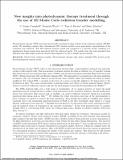Files in this item
New insights into photodynamic therapy treatment through the use of 3D Monte Carlo radiation transfer modelling
Item metadata
| dc.contributor.author | Campbell, C. Louise | |
| dc.contributor.author | Wood, Kenneth | |
| dc.contributor.author | Brown, C. Tom A | |
| dc.contributor.author | Moseley, Harry | |
| dc.contributor.editor | Choi, Bernard | |
| dc.contributor.editor | Kollias, Nikiforos | |
| dc.contributor.editor | Zeng, Haishan | |
| dc.contributor.editor | Wook Kang, Hyun | |
| dc.contributor.editor | Wong, Brian J F | |
| dc.contributor.editor | Ilgner, Justus F | |
| dc.contributor.editor | Tearney, Guillermo J | |
| dc.contributor.editor | Gregory, Kenton W | |
| dc.contributor.editor | Marcu, Laura | |
| dc.contributor.editor | Skala, Melissa C | |
| dc.contributor.editor | Campagnola, Paul J | |
| dc.contributor.editor | Mandelis, Andreas | |
| dc.contributor.editor | Morris, Michael D | |
| dc.date.accessioned | 2016-06-21T15:30:03Z | |
| dc.date.available | 2016-06-21T15:30:03Z | |
| dc.date.issued | 2016-02-29 | |
| dc.identifier | 243564707 | |
| dc.identifier | 0c47628b-4604-4d40-86ab-d42626c8d784 | |
| dc.identifier | 84973369413 | |
| dc.identifier | 000377396200022 | |
| dc.identifier.citation | Campbell , C L , Wood , K , Brown , C T A & Moseley , H 2016 , New insights into photodynamic therapy treatment through the use of 3D Monte Carlo radiation transfer modelling . in B Choi , N Kollias , H Zeng , H Wook Kang , B J F Wong , J F Ilgner , G J Tearney , K W Gregory , L Marcu , M C Skala , P J Campagnola , A Mandelis & M D Morris (eds) , Photonic Therapeutics and Diagnostics XII . , 96890Q , Proceedings of SPIE , vol. 9689 , SPIE , Photonic Therapeutics and Diagnostics XII , San Francisco , United States , 13/02/16 . https://doi.org/10.1117/12.2212240 | en |
| dc.identifier.citation | conference | en |
| dc.identifier.isbn | 9781628419245 | |
| dc.identifier.issn | 0277-786X | |
| dc.identifier.other | ORCID: /0000-0002-4405-6677/work/86537153 | |
| dc.identifier.uri | https://hdl.handle.net/10023/9027 | |
| dc.description | We acknowledge the support of the UK Engineering and Physics Sciences Research Council (EPSRC) for funding through a studentship for C L Campbell (EP/K503162/1), the Alfred Stewart Trust as well as the BMLA Education Award. | en |
| dc.description.abstract | Photodynamic therapy (PDT) has been theoretically investigated using a Monte Carlo radiation transfer (MCRT) model. By including complex three dimensional (3D) tumour models a more appropriate representation of the treatment was achieved. The 3D clustered tumour model was compared to a smooth model, resulting in a significantly deeper penetration associated with the clustered model. The results from the work presented here indicates that light might penetrate deeper than suggested by 2D or simple layered models. | |
| dc.format.extent | 553414 | |
| dc.language.iso | eng | |
| dc.publisher | SPIE | |
| dc.relation.ispartof | Photonic Therapeutics and Diagnostics XII | en |
| dc.relation.ispartofseries | Proceedings of SPIE | en |
| dc.subject | Daylight PDT | en |
| dc.subject | Fractal model | en |
| dc.subject | Monte Carlo radiation transfer | en |
| dc.subject | Non-homogeneous tumour model | en |
| dc.subject | Photodynamic therapy | en |
| dc.subject | Skin optics | en |
| dc.subject | Atomic and Molecular Physics, and Optics | en |
| dc.subject | Electronic, Optical and Magnetic Materials | en |
| dc.subject | Biomaterials | en |
| dc.subject | Radiology Nuclear Medicine and imaging | en |
| dc.subject | NDAS | en |
| dc.title | New insights into photodynamic therapy treatment through the use of 3D Monte Carlo radiation transfer modelling | en |
| dc.type | Conference item | en |
| dc.contributor.institution | University of St Andrews. School of Physics and Astronomy | en |
| dc.identifier.doi | https://doi.org/10.1117/12.2212240 |
This item appears in the following Collection(s)
Items in the St Andrews Research Repository are protected by copyright, with all rights reserved, unless otherwise indicated.

